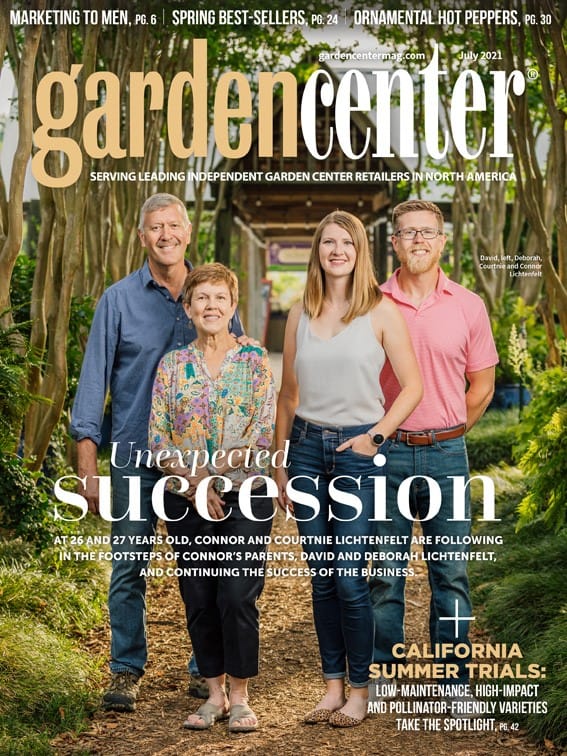

Growing and thriving as an independent garden center means making meaningful connections and engaging with our customers on a level that feels authentic and natural. For our own sake, and that of our audience. When it comes to customer targeting and marketing, what feels natural to women and men often differs greatly. When deciding on whether to cater to one or the other, your choice and strategy should reflect your core business goals and values, and, of course, the products and services you think can garner you the most profit.
Typically, garden center customer demographics are so varied that it behooves most businesses to develop multiple customer avatars, then target each one when and how it makes the most sense. That said, there’s nothing wrong with going all-in for one primary customer profile — or sex — if putting all your eggs in that basket makes sense for your business.
Generally speaking, men tend to be loyal to specific brands they can relate to, while women tend to be much more loyal to good service, regardless of brand. Good service for men often equates to being able to find exactly the product they need quickly and without assistance. For women, good customer service is often far more nuanced. The experience and trust-building become more important. How you speak to women and the experience they’ll have, not just the products you have on hand, is a crucial differentiator. So, are you a product- and convenience-focused operation, or are you more experience-focused?
While the bulk of our IGC customers have traditionally been women, I’ve been asked if it’s a smart idea for garden centers to cater directly to a male audience. More specifically, how would a garden center know if this is a good strategy? Well, I suppose that depends on your goals, specific products and services, and your location within your city or region. Your local demographics, and from how far you tend to draw customers, should always be a major factor in who and how you target. It’s also important, when choosing a target customer, to consider overall consumer trends related to what you offer. The percentage of Americans engaged in lawn care plus gardening activities bottomed out big time in 2019. In 2019 The U.S. Bureau of Labor Statistics’ American Time Use Survey showed a historic low of only 8.7% of Americans 15 years and older engaged in lawn care and related gardening activities (tilling, hardscape, etc.). More and more, lawn care and such heavier gardening tasks often taken on by the male gardener of the house, have been outsourced.
The COVID-19 pandemic, however, decidedly swung the pendulum in the opposite direction, nearly doubling the number of first-time gardeners in 2020. That said, flower gardening, vegetable gardening, wildlife support and houseplants (versus lawn care and traditional heavy DIY landscaping) headline the consumer conversation. So, taking a male-centric approach to your IGC marketing could be a risky endeavor if you expect to grow sales in traditional lawn and landscape products. If, however, you’ve pivoted to offer more edibles, wildlife-friendly plants, and indoor gardening plants and products, then you may have more success.
Conventional generalities aside, I’ve seen a visible uptick in young male gardeners making their new plant passions public, especially when it comes to their houseplants and vegetable gardens. I’ve also observed plant-related interests becoming more homogeneous between the sexes. Women appear to be doing a lot more landscaping and garden building, and men are digging into a lot more flower and indoor gardening. Therefore, differentiating between a male and female audience within your customer base — at least when it comes to product and service categories — will probably become less important over time. Younger gardeners of both sexes also tend to ally more closely with brands they feel they can trust, from a big-picture standpoint.
Sustainability, transparency, authenticity and lifestyle relevance all play heavily in building trust with the next generation of gardeners — male and female alike.
Ultimately, figuring out how to target both women and men distinctly and appropriately within your customer base comes down to understanding their pain points and how they correlate to your business goals. What problems do women need solved, versus men, when it comes to the products and services you have to offer? Time is a critical pain point for most people but women who are juggling primary childcare duties, domestic duties and an outside job bear a distinct burden. This is one of the reasons the experience they have during the time they give you is so important. Convenience and productivity are often classic male consumer pain points, so having what they need when they want it on demand is non-negotiable. Again, these are generalities — and these pain points cross over to both sexes — but generalities exist for a reason.
When deciding whether to cater primarily to either men or women — or both equally — always fall back to your primary company mission and goals. Having a clear company identity, value system and brand will always help guide you to the right customer.

Explore the July 2021 Issue
Check out more from this issue and find your next story to read.
Latest from Garden Center
- GS1 US Celebrates 50-Year Barcode 'Scanniversary' and Heralds Next-Generation Barcode to Support Modern Commerce
- Weekend Reading 7/26/24
- Retail Revival: Making gardening contagious
- ‘Part of our story’
- Registration now open for Garden Center Fertile Ground Webinar Series
- Dramm introduces new hose, sprinkler attachments for home gardeners, nurseries
- Meet the 15 Retailers' Choice Awards winners from Cultivate'24
- 2024 Top 100 Independent Garden Centers List





